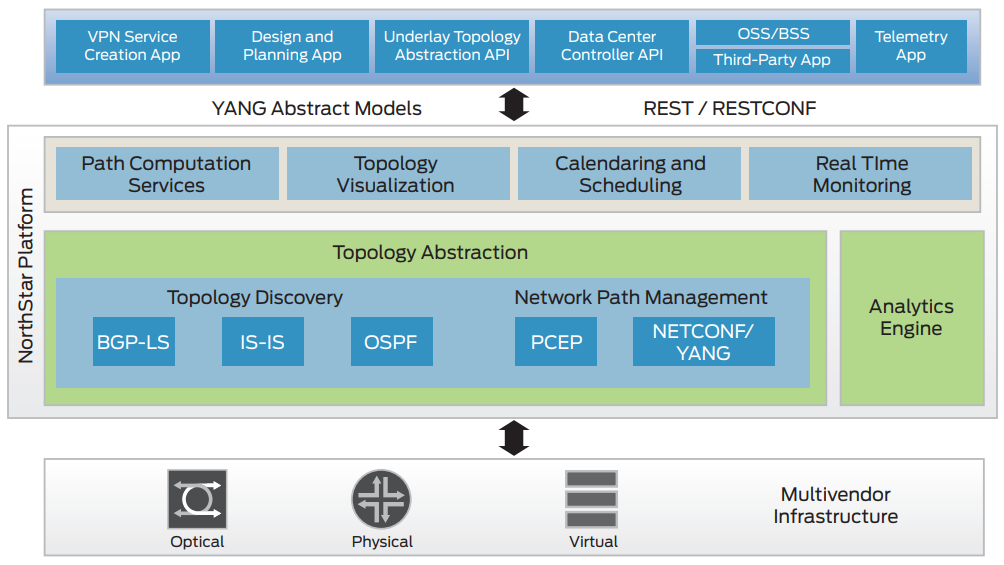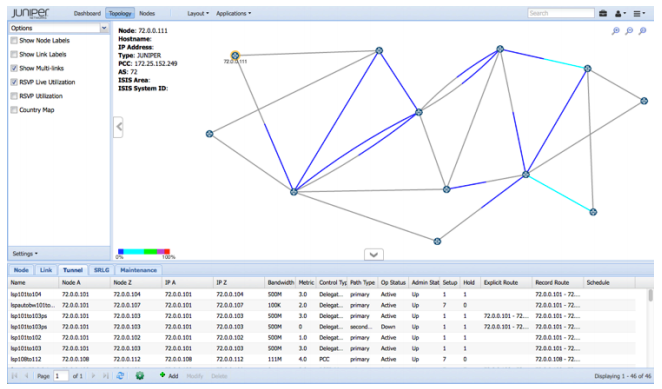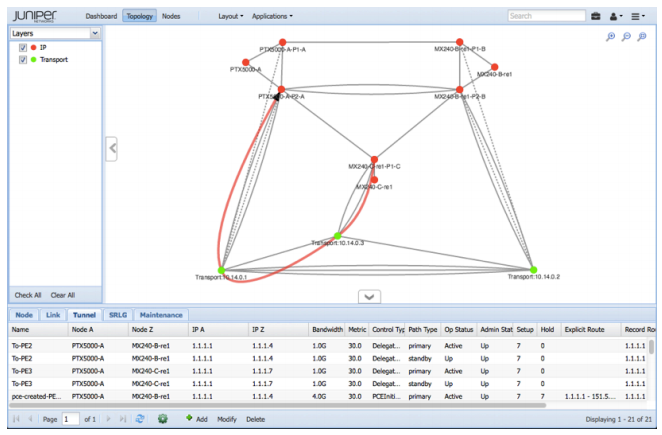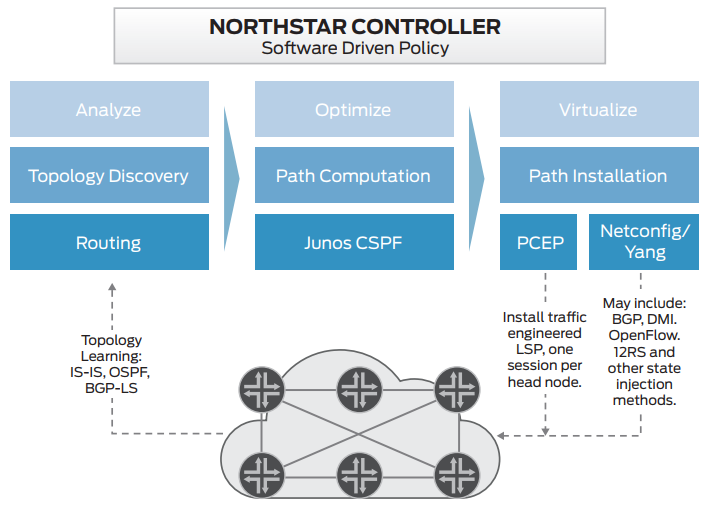Overview:
Juniper Networks NorthStar Controller is a powerful and flexible traffic-engineering solution that enables granular visibility and control of IP/MPLS flows in large service provider and enterprise networks. It enables network operators to optimize their network infrastructure through proactive monitoring, planning, and explicit routing of large traffic loads dynamically based on the constraints specified. This allows operators to run their networks “hotter” while ensuring predictability, resiliency, and service-level guarantees. NorthStar Controller leverages IETF and Web protocol standards to ensure seamless integration into multivendor infrastructure and existing OSS/BSS systems. NorthStar Controller is industry’s first multi-layer controller that can dynamically interact with transport/optical controllers and reroute IP/MPLS flows, adapting to real-time changes in multiple layers.
Product Description
Service providers and large enterprises are under increasing pressure to rapidly deploy services while reducing overall CapEx and OpEx. It is no longer economically viable to tolerate the idle network infrastructure while passively anticipating the growth needs. Network managers need to move to an operational model where capacity upgrades are targeted, service-driven, and can adapt dynamically to ever-changing needs of their customers in real time.
Architecture and Key Components:
Juniper Networks NorthStar Controller is based on the Path Computation Element (PCE) architecture as defined in RFC 5440. It specifically leverages the “active stateful PCE” concept, which enables it to learn about the network and LSP path state via the Path Computation Element Protocol (PCEP) by communication with a client-side component present in the network devices themselves. The client is referred to as a Path Computation Client (PCC).
The stateful PCE implementation in NorthStar Controller provides the following functions:
- Offers real-time LSP path computation and provisioning
- Provides global optimization of LSPs
- Triggers LSP reroute when there is a need to reoptimize the network
- Changes LSP bandwidth when there is an increase in bandwidth demand from an application
- Modifies other LSP attributes on the router, such as ERO, setup priority, and hold priority
Additionally, NorthStar Controller is able to discover the topology of the network dynamically by peering via IGP (ISIS-TE, OSPF-TE) and listening to BGP-LS updates, while the discovery of optical network topology and optical virtual paths can be done via REST API calls using notion of Abstract topology as defined in IETF standards into the optical plane. Modification of existing paths or provisioning new paths can be achieved through PCEP standard and service mapping with NETCONF/YANG.
Source Packet Routing in Networks (SPRING) is an SDN-enabled method of routing where a centralized controller maintains network resources and directs traffic based on the application’s needs. NorthStar Controller can also receive real-time performance monitoring data from the Junos Telemetry Interface or other similar solutions. By streaming data to a performance management system, network administrators can measure trends in link and node utilization, and troubleshoot issues such as network congestion in real time.

Figure 1. NorthStar architecture
Operations
NorthStar Controller has a global view of the bandwidth demand in the network and performs external path computations after querying the traffic engineering database. It then modifies one or more LSP attributes and sends an update to the client (PCC). The client uses the parameters it receives from NorthStar Controller to resignal the LSP. This allows NorthStar Controller to provide a cooperative operation of distributed functionality used to address specific challenges of a shortest interdomain constrained path computation. It eliminates congestion scenarios in which traffic streams are inefficiently mapped onto available resources causing overutilization of some subsets of network resources, while other resources remain underutilized.
On the management side, NorthStar Controller has a set of standard web-based northbound interfaces that are RESTful/ Thrift-based APIs that enable ease of integration with existing OSS/BSS systems, third-party traffic modeling/planning scripts, or custom applications. This rich set of controls allows NorthStar Controller to interoperate with most incumbent programmable network management systems.

Figure 2. NorthStar live network visualization
Multi Layer Packet Optical Integration
NorthStar Controller provides operators with multi-layer views of the network by interacting dynamically with transport controllers. Operators no longer need to manually configure Shared Risk Link Groups (SRLGs) on network devices to plan LSPs. Instead, NorthStar Controller communicates directly with transport controllers via REST/RESTCONF to learn the abstract topology as defined by IETF standards, making it a true multivendor solution.
NorthStar Controller helps operators design diverse-path creations (LSPs) without having to manually configure SRLG on network devices. NorthStar also gets real-time updates from transport controllers, enabling operators to perform optimization tasks such as multi-layer network design and planning as well as coordinated packet and optical node maintenance planning.

Figure 3. Multi-layer network view

Figure 4. Typical NorthStar Controller workflow
Features and Benefits:
Key Features
- Complex Interdomain path-computation and network optimization
- Sophisticated industry-leading path computation algorithms
- Ability to address multilayer optimization with multiple userdefined constraints
- Intelligent interface between RSVP-TE networks and SPRING-enabled networks
- Customizable display includes ability to rearrange fields and create node, link, LSP, or SRLG views
- Typical applications and use cases include:
- Explicit path routing with predictable and deterministic failover
- IP/MPLS global LSP path/bandwidth optimization
- Flexible bandwidth calendaring
- Coordinated network optimization performed during maintenance windows helps maintain SLAs and supports automatic path restoration
- Network defragmentation (bin packing) with traffic engineering (TE)++
- Path diversity with partially/wholly disjoint head-ends and shared risk link groups (SRLG)
- Programmable user-defined cost function
- Network Visualization
- IGP metric optimization
- High controller availability and geographic redundancy (active/standby and active/active)
Benefits
Key benefits of the NorthStar Controller application architecture include the following;
- Provides specific ordering and synchronization of paths signaled across routed network elements
- Allows global view of network state for monitoring, management, and proactive planning
- Features predictable, deterministic network state within margin of demand forecast error
- Offers minimized distributed state, increased efficiency of existing network elements via offloading of control plane processing
- Can act as a foundation for additional centralized network infrastructure services—API for the network
- Provides operational simplicity through enabling of an SDN control point across disparate elements across the network
Specifications:
Standard protocol support:
- Path Control Element (RFC 4655)
- Path Computation Element (PCE) Communication Protocol (PCEP) – (RFC 5440)
- OSPF–TE (based on Juniper Networks Junos operating system)
- ISIS-TE (based on Junos OS)
- BGP-LS (based on Junos OS)
- NETCONF (based on Junos OS)
- Representational State Transfer (REST)
- REST CONF (IETF draft)
- Abstract Topology (IETF draft)
Supported Platforms
- Juniper Network Routers: MX including vMX, PTX, M Series, and T Series.
- 3rd Party Routers supporting RFC 5440
System and operating environment recommendations:
- Hardware: 64-bit dual x86 processor, minimum memory 16 GB RAM (quad-core x86 with 32 GB or more of memory recommended)
- Storage: 1Tb Serial Advanced Technology Attachment (SATA), Serial Attached SCSI (SAS), or solid-state drive (SSD); Volume storage: 2 disks with 2 TB SATA
- Network: 1/10 GB interface card (2)
- OS: Linux OS (CentOS 6.4, RHEL 6.4) with kernel-based virtual machine (KVM) support





